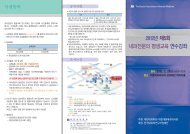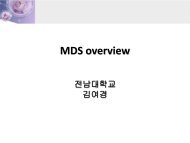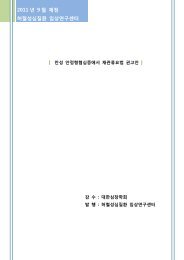Clinical
Clinical
Clinical
You also want an ePaper? Increase the reach of your titles
YUMPU automatically turns print PDFs into web optimized ePapers that Google loves.
The assessment of men for androgen deficiency should<br />
include a general health evaluation to exclude systemic<br />
illness, use of certain medications (e.g., opiates or highdose<br />
glucocorticoid therapy) and recreational drugs that<br />
affect testosterone production or metabolism, eating<br />
disorders, and excessive exercise (2) because these<br />
conditions can lower testosterone levels transiently.<br />
The diagnosis of androgen deficiency should not be<br />
made during an acute illness.<br />
1.1.C VALUES<br />
Our proposed diagnostic strategy places higher value on<br />
avoiding the labeling of men with low testosterone<br />
levels due to SHBG abnormalities, natural variations in<br />
testosterone levels, or transient disorders, and lower<br />
value on treatment of men without unequivocally low<br />
testosterone levels and symptoms in whom the benefits<br />
and risks of testosterone therapy are unclear.<br />
1.1.1 Further Evaluation of Men Deemed Androgen<br />
Deficient (Fig. 1)<br />
1.1.1.A RECOMMENDATIONS<br />
We recommend measurement of serum LH and<br />
FSH levels to distinguish between primary (testicular)<br />
and secondary (pituitaryhypothalamic) hypogonadism.<br />
(1| )<br />
In men with secondary hypogonadism, we suggest further<br />
evaluation on an individualized basis to identify the<br />
etiology of hypothalamic and/or pituitary dysfunction.<br />
This evaluation may include measurements of serum<br />
prolactin and iron saturation, pituitary function testing,<br />
and magnetic resonance imaging (MRI) scanning.<br />
(2| )<br />
History and physical (symptoms and signs)<br />
Morning Total T<br />
Normal T<br />
< 300 ng/dL #<br />
Low T<br />
Follow up<br />
Exclude reversible illness, drugs, nutritional deficiency<br />
Repeat T [use free or bio T, if suspect altered SHBG^]<br />
LH+FSH<br />
SFA [if fertility issue]<br />
THE ENDOCRINE SOCIETY’S CLINICAL GUIDELINES<br />
Confirmed low T [e.g. Total T < 300ng/dL # ; or free or bio T <<br />
normal (e.g. free T < 5ng/DL @ )]<br />
Low T, low or normal LH+FSH (2°)<br />
Prolactin, iron, other pituitary hormones,<br />
MRI [under certain circumstances*]<br />
Low T, high LH+FSH (1°)<br />
Karyotype<br />
[Klinefelter syndrome]<br />
Normal T, LH+FSH<br />
FIG. 1. An approach for the diagnostic evaluation of adult men suspected of having androgen deficiency. T, Testosterone; bio T, bioavailable T; SFA, seminal fluid<br />
analysis; 1°, primary testicular failure; 2°, secondary hypogonadism. #, In some laboratories, the lower limit of the normal testosterone range in healthy young men is<br />
approximately 300 ng/dL (10.4 nmol/L); however, this range may vary in different laboratories. Use the lower limit of the range established in your reference<br />
laboratory. ^, Refer to Table 2 for a list of conditions that alterSHBGconcentrations. @, In some reference laboratories, the lower limit of the normal free testosterone<br />
range in healthy young men is approximately 5 ng/dL (0.17 nmol/L) (approximate lower limit of normal in three major commercial laboratories) using equilibrium<br />
dialysis or calculated from total testosterone and SHBG; however, this range may vary in different laboratories [approximate lower limits of normal ranging from 4 to 9<br />
ng/dL (0.14 to 0.31 nmol/L) in major commercial laboratories) using equilibrium dialysis or calculated from total testosterone and SHBG and the reference population<br />
used. Use the lower limit of the range established in your reference laboratory. *, Perform pituitary imaging (MRI) to exclude pituitary and/or hypothalamic tumor or<br />
infiltrative disease, if severe secondary hypogonadism (serum T < 150 ng/dL), panhypopituitarism, persistent hyperprolactinemia, or symptoms or signs of tumor mass<br />
effect, such as headache, visual impairment, or visual field defect, are present.<br />
6

















